
One hundred years ago today—June 17, 1922—Fort Worth’s first municipal swimming pool opened: a vast circular concrete ocean in Forest Park. The current Forest Park pool was built in 1967. On May 7 voters approved a bond issue to fund replacing the 1967 Forest Park pool with a smaller pool.
The city also operates a second pool—in Marine Park on Northwest 20th Street on the North Side.
If you’re counting, that’s two municipal swimming pools in a city of 900,000.
Ah, but once upon a time Fort Worth was awash with municipal swimming pools.
And why not? Texas summers are brutal. During the golden age of municipal swimming pools we had fewer diversions to choose among, and city swimming pools were always among the favorites. Before kids had air-conditioned malls in which to congregate, they met at city swimming pools to socialize, to get cool, and—just as important—to act cool. Maybe Mom, driving the family Studebaker or Hudson, dropped her kids off at the pool. Or maybe the kids rode their Schwinns and Huffys to the pool, where they spent the day gawking at the opposite sex and gorging on Moon Pies and Milk Duds from the concession stand.
Teenagers congregated at city pools during the day and at Carlson’s and the Clover drive-in restaurants at night. City pools are where we learned to swim, to flirt, to appreciate the fragrance distilled of Coppertone and chlorine: Eau de August.
Here’s a brief review of some of the swimming pools—municipal and commercial—that, like miniature golf courses, penny arcades, and amusement parks, are but a memory. (At the bottom of the post a map locates these pools.)
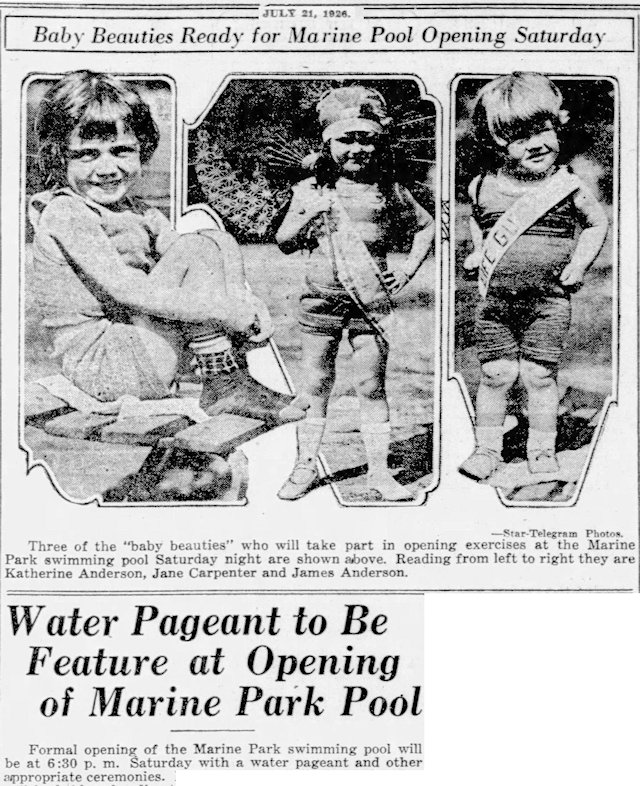
The pool in Marine Park opened in 1926. Like the Forest Park pool, today’s Marine pool is not the original.

The city opened two more pools in 1926.
Dixie Park on East Rosedale Street at Fabons Street (across from the Grand Theater) had opened about 1922 as a privately operated park for African Americans. The near East Side had long been the center of Fort Worth’s African-American community. The black-and-white aerial photo is from 1952.
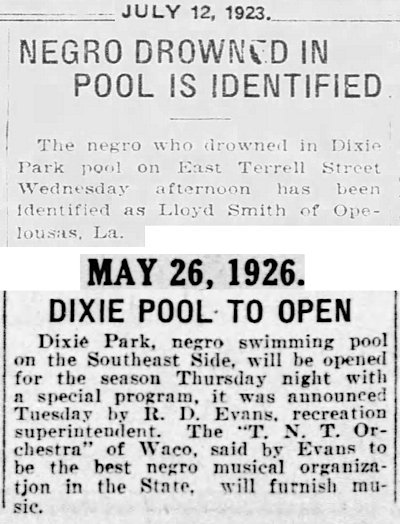
Dixie Park had a swimming pool by at least 1923. The park was taken over by the city by 1926.
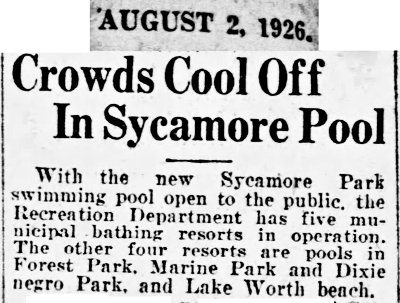
Also in 1926 a pool opened in Sycamore Park in Polytechnic.
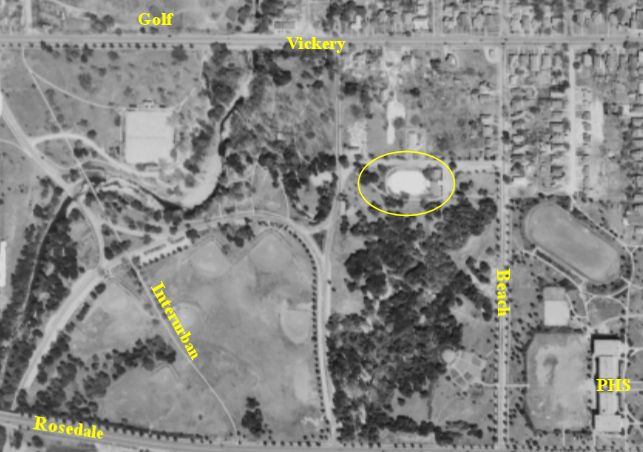
This 1952 aerial photo shows Sycamore pool, Poly High School, Vickery Boulevard, Rosedale Street, and Sycamore golf course.
The sidewalk through the park crossed Sycamore Creek on the narrow iron bridge that had carried the interurban track to Cleburne. The sidewalk followed the right-of-way of the track, which then ran along today’s Mitchell Boulevard.
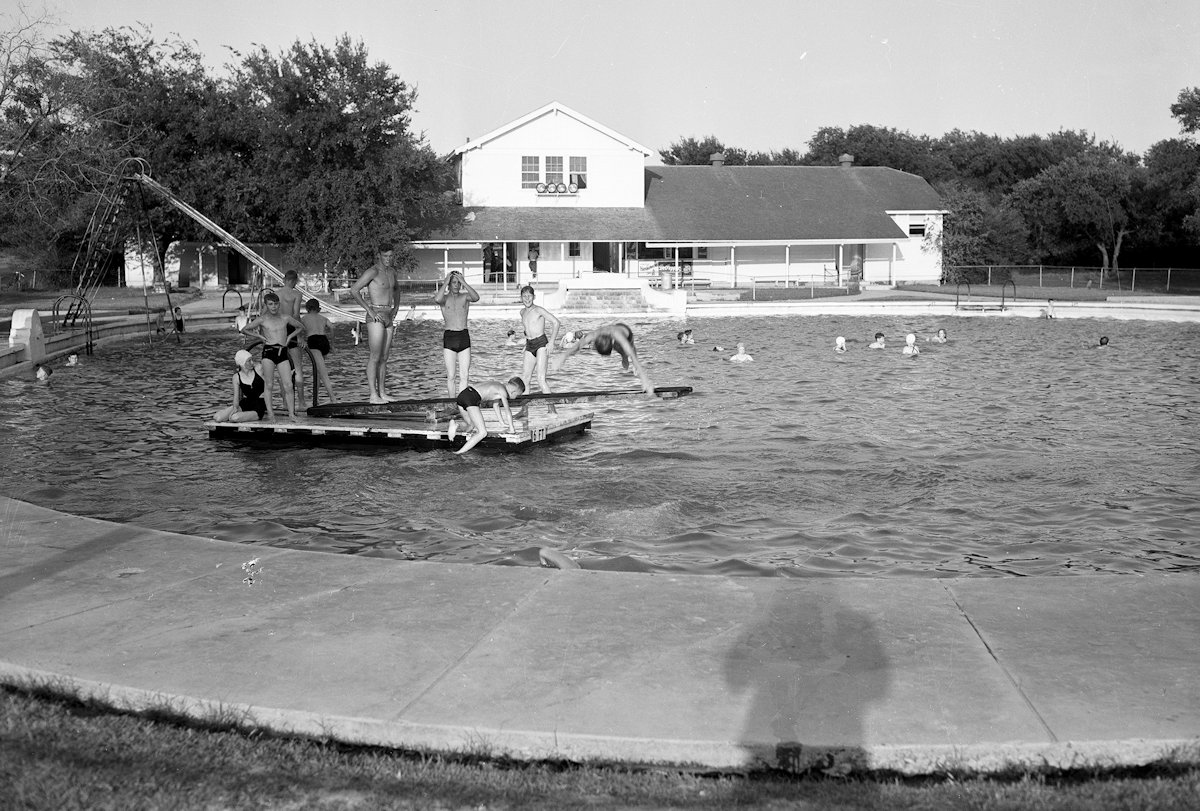
Sycamore pool in 1940. (Photo from University of Texas at Arlington Star-Telegram Collection.)
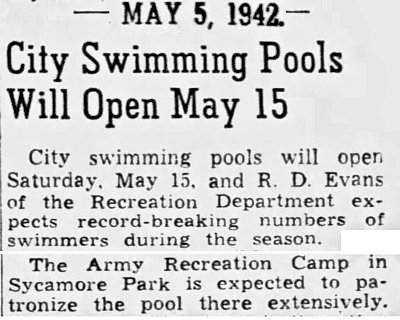
In 1941 an Army recreation camp was set up on the west side of Sycamore Park. The soldiers had only to cross the creek to get to the pool.
Marine, Sycamore, and Dixie pools, like Forest Park pool, were opened during the tenure of park superintendent George C. Clarke.
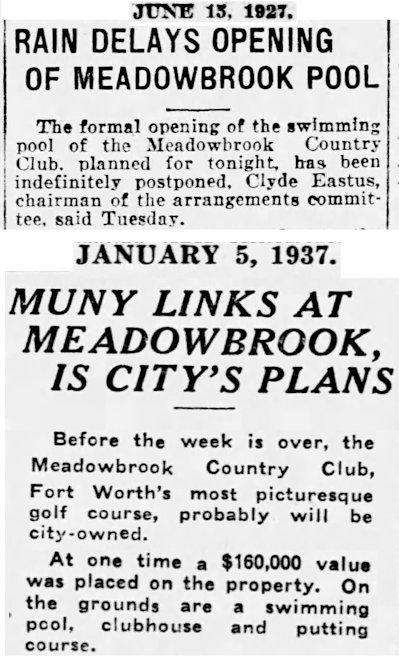
Meadowbrook Country Club opened in 1924 at 1815 Jenson Road north of Meadowbrook Drive. The club added a swimming pool in 1927. Ten years later the city bought the country club, giving the city another municipal swimming pool.
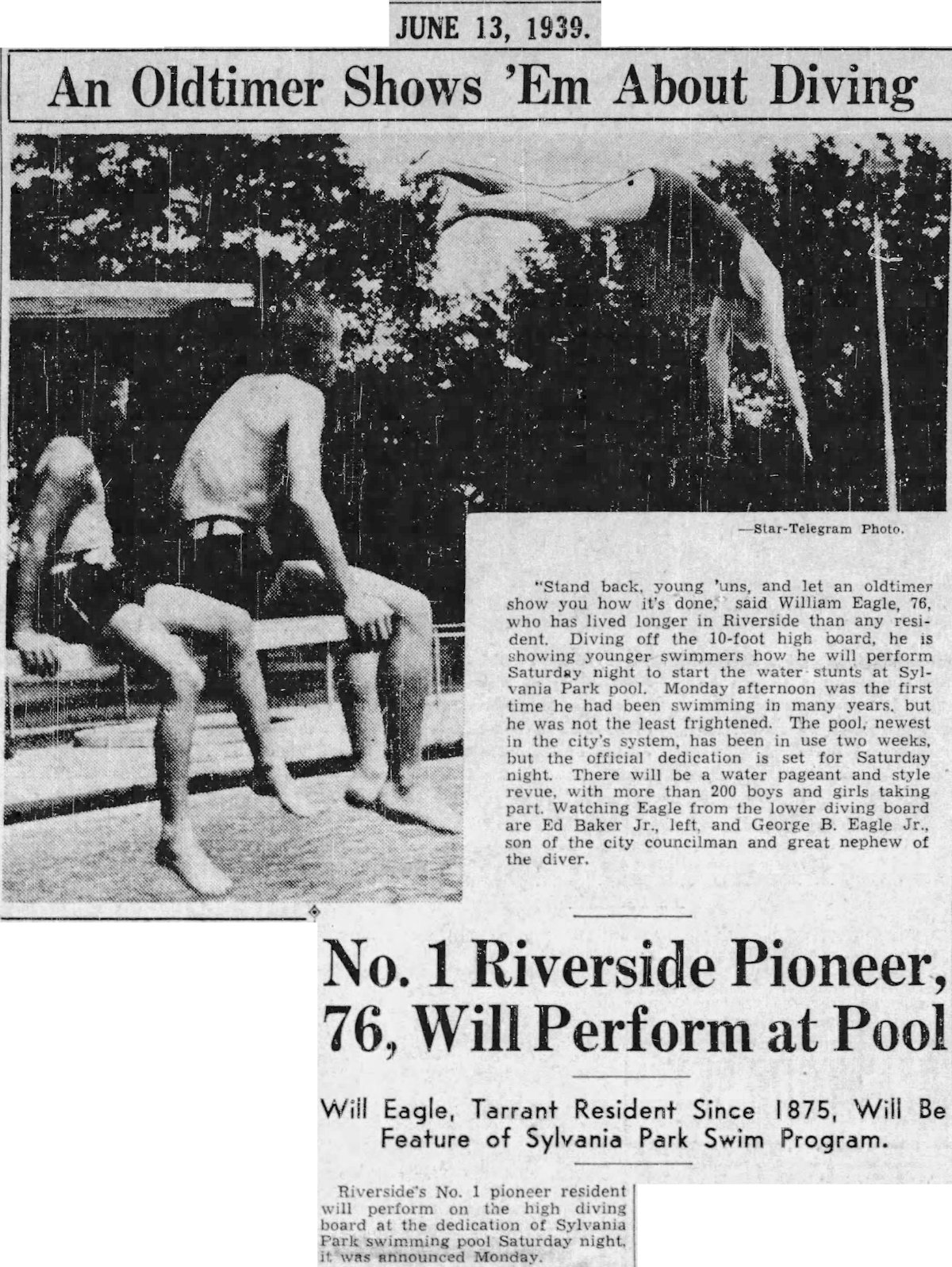
In 1939 a swimming pool opened in Sylvania Park on East Belknap Street in the Riverside area. Among those celebrating the dedication with a dive off the high board was William Eagle, seventy-six, “Riverside’s No. 1 pioneer resident.” Eagle had moved to Tarrant County in 1875.

Sylvania pool in 1939. (Photo from University of Texas at Arlington Star-Telegram Collection.)
From 1939 to 1957 Fort Worth pools were Forest Park, Marine, Dixie, Sycamore, Meadowbrook, and Sylvania.
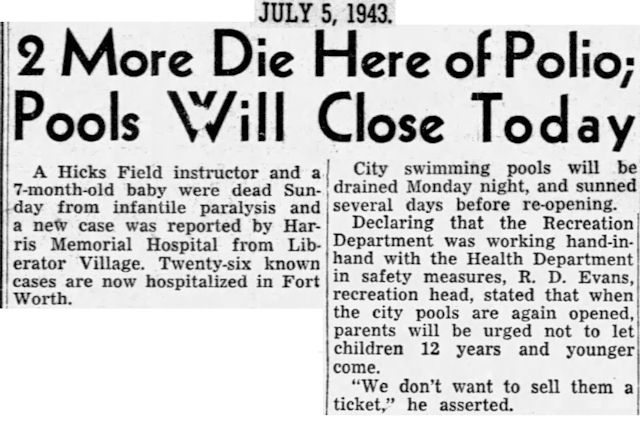
Polio outbreaks always sent a ripple of fear over swimming pools. In fact, the city closed its pools in 1943 after two local people died.
The city closed its pools again after the flood of May 1949. Oh, the heavy rain had filled the pools all right, but the city was keeping that water ready for emergency use by the fire department because the flood had disrupted the city’s water system.

In 1957 the city opened a pool for African Americans in Lake Como Park in Arlington Heights, bringing the number of municipal pools to seven.
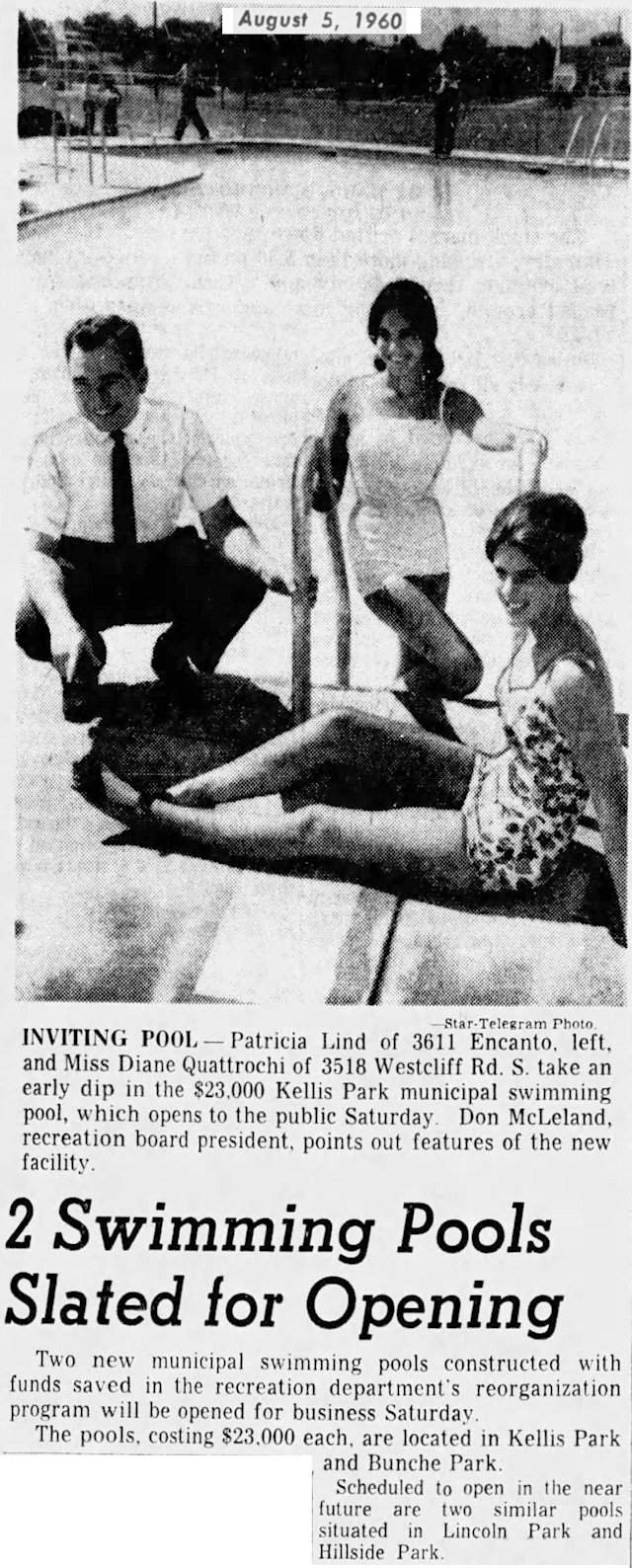
The year 1960 was the high-water mark in the history of Fort Worth municipal swimming pools. The city opened four: Hillside, Lincoln, Bunche, and Kellis.
Hillside, Lincoln, and Bunche were built for African Americans. (Until the early 1970s Fort Worth’s municipal pools were segregated. African-American swimmers were allowed into one white pool once a year: Forest Park on Juneteenth.)
Hillside Park is on East Maddox Street on the East Side.
Bunche Park is on Ramey Avenue next to Dunbar High School in the Stop 6 neighborhood. (Ralph Johnson Bunche was a civil rights leader and the first African American to win the Nobel Peace Prize.)
Lincoln Park is on Northwest 30th Street along Marine Creek on the North Side.
Kellis Park is in southwest Fort Worth on South Ridge Terrace just south of Seminary Drive.
The land for the park—fifteen acres—was donated to the city by J. E. Foster when he developed the surrounding Kellis Park housing addition. (Nearby Foster Park is named for him.)
Most of the city’s eleven pools were in the central city. Kellis Park, six miles from the courthouse, was easily the outlier. But southwest Fort Worth, especially Wedgwood, was booming in the early 1960s.
With the opening for four pools in 1960, the city reached a high of eleven. But that total dropped to ten in 1962 when the city closed Dixie Park, calling it “obsolete.”
In fact, after the city reached its high of eleven pools, in 1963 the city reported that pools were operating at a loss. The city attributed the drop in revenue to (1) homeowners with children moving farther out, away from the central city and (2) backyard pools being built.

Webfooted celebrities Esther Williams and Johnny Weissmuller were cashing in on the popularity of backyard pools.
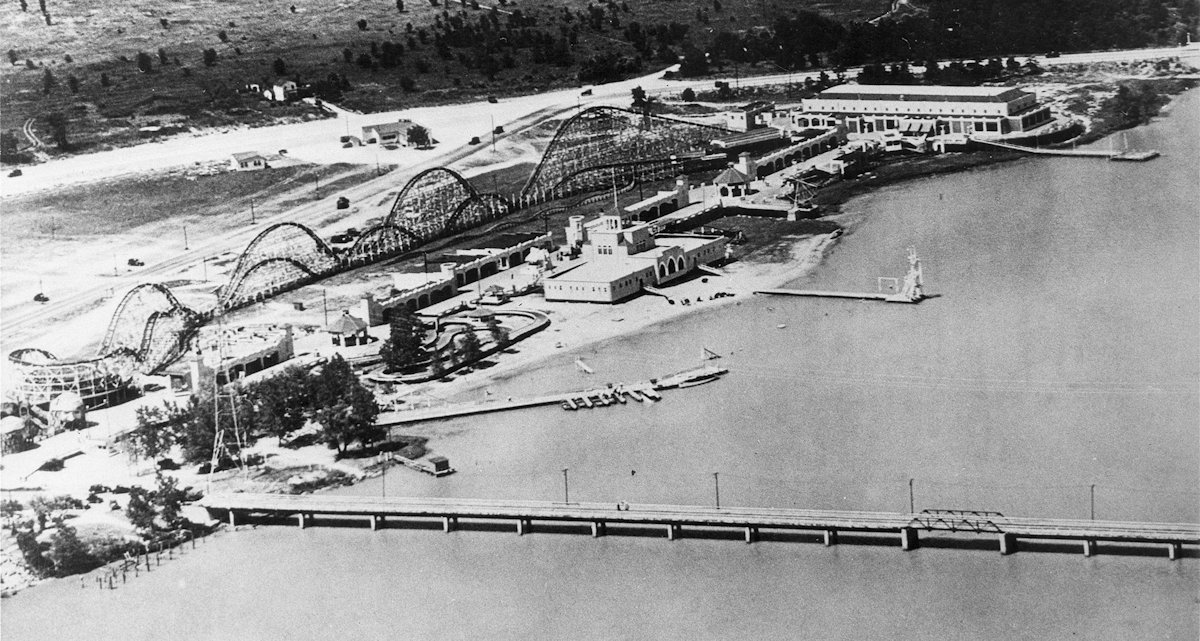
And there were more lakes with beaches. When the first city pool had been built in 1922, Lake Worth was the only lake with a beach (Casino, pictured). By 1963 Eagle Mountain, Benbrook, Grapevine, and Arlington lakes had been built. Their beaches added to the competition for city pools. (Photo from University of Texas at Arlington Libraries.)
Also, country clubs and YMCAs had swimming pools.
Nonetheless, after closing Dixie Park in 1962, the city kept the remaining ten pools open through the sixties. In 1970 the city pools were Forest Park, Sylvania, Kellis, Meadowbrook, Hillside, Como, Bunche, Lincoln, Sycamore, Marine.
By 1980 there were seven: Forest Park, Sylvania, Kellis, Meadowbrook, Hillside, Como, Marine.
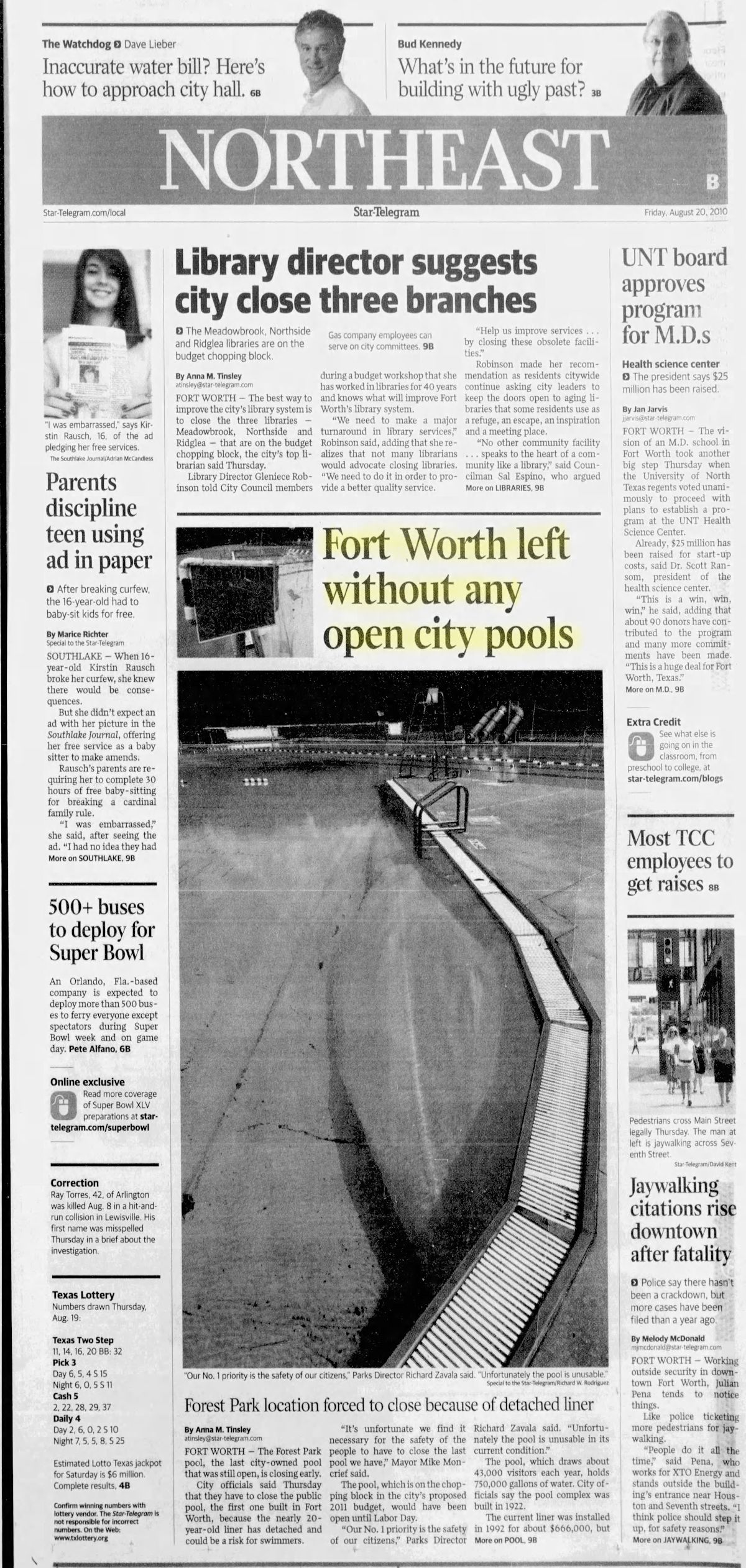
Dog-paddle ahead thirty years to 2010. In August, with another month of Texas heat still to suffer, Fort Worth swimmers were suddenly left high and dry. The city closed Forest Park pool because its liner had become detached. That left the city with no operating pools because the other six—Como, Hillside, Kellis, Marine, Sycamore, Sylvania—had been closed because of budget cuts.
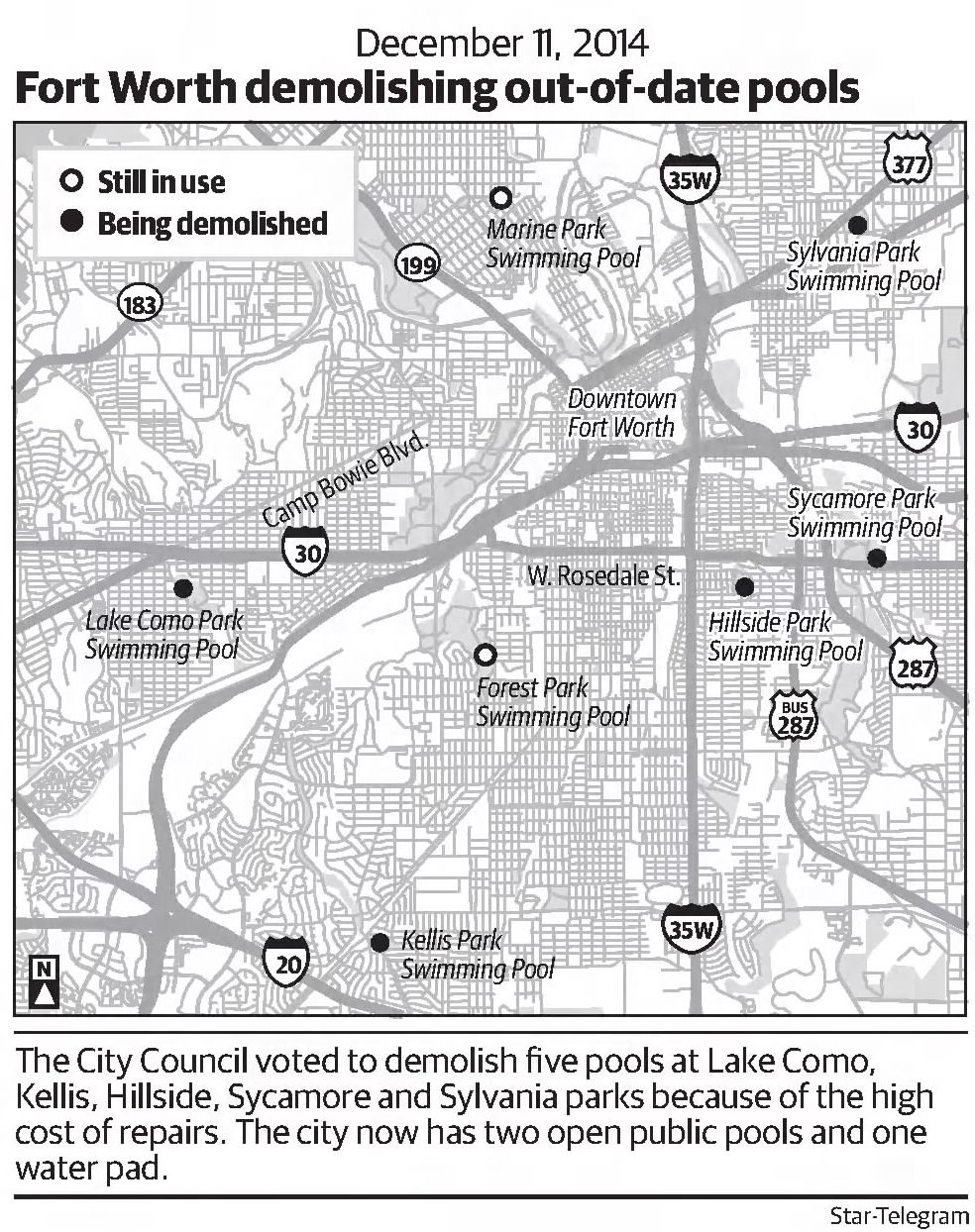
In 2014 the city council voted to demolish Como, Kellis, Hillside, Sycamore, and Sylvania pools.
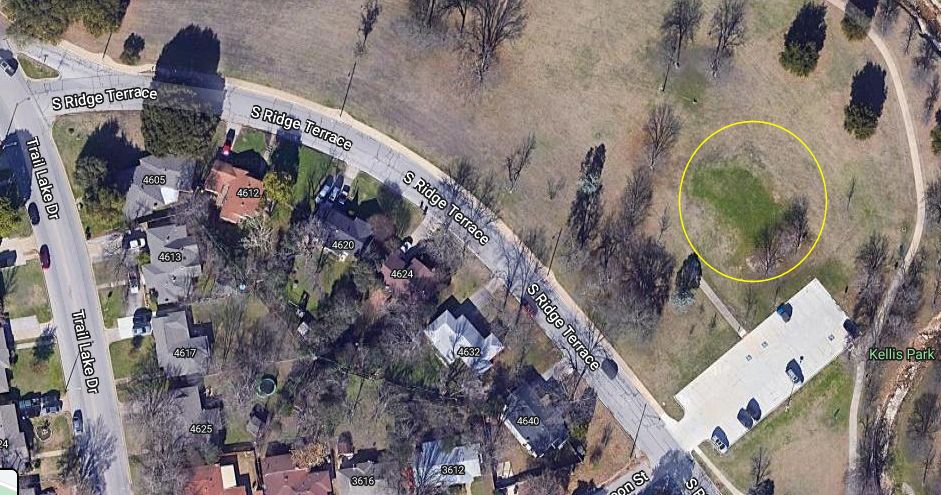
Today only a rectangle of green grass marks where Kellis Park pool was.
After the Great Drain of 2010, the city reopened Forest Park and Marine pools, and the count remains at two today.
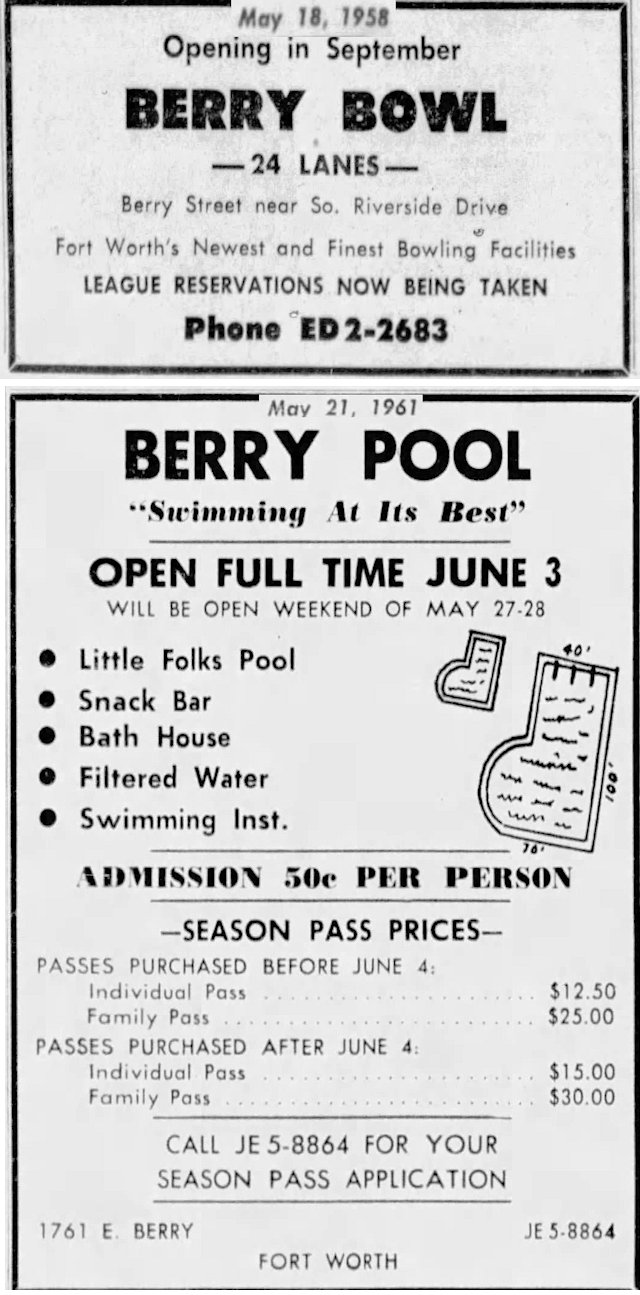
But in addition to Fort Worth municipal pools, there were a few commercial pools. Such as Berry Pool on East Berry Street just east of Ward Plaza.
Berry Pool opened in 1961 next to Berry Bowl, which had opened in 1958. The pool closed about 1968. The bowling alley operated into the 1980s.
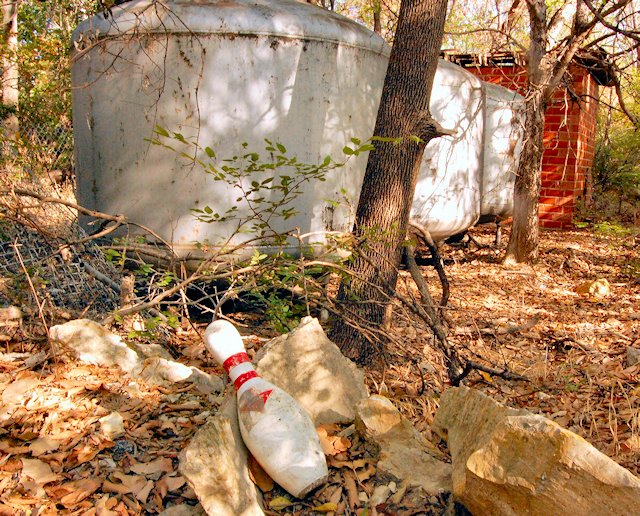
Nature has reclaimed the site of Berry Bowl and Berry Pool. When I poked around there a few years ago I found a pin from Berry Bowl near the Berry Pool filters. Berry Pool was located in what is now the parking lot of Apostolic Faith Church on the edge of Cobb Park.
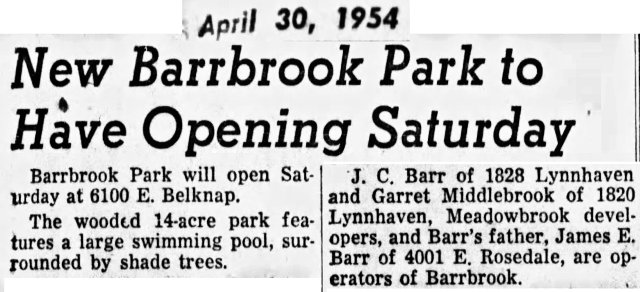
Two popular commercial swimming pools technically were not in Fort Worth.
The first was Barrbrook, which was in Haltom City. The park opened in 1954, named for its developers, neighbors J. C. Barr and Garret Middlebrook.
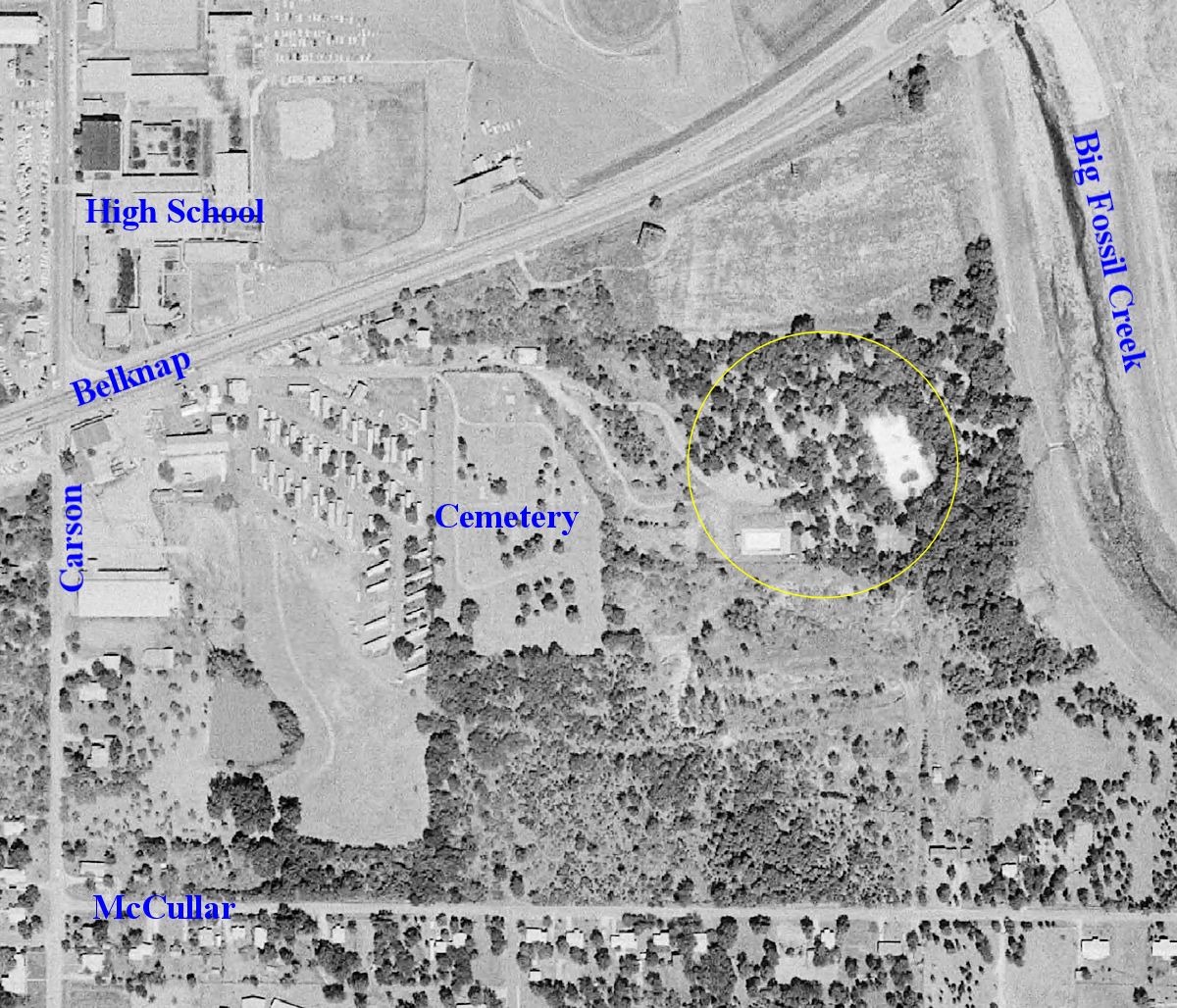
Barrbrook was both secluded and surrounded. Just south of Haltom High School a dirt road off busy East Belknap Street led past a mobile home park and Birdville Cemetery to the fourteen tree-shaded acres of Barrbrook park. This 1968 photo shows that the park had two pools: one Olympic and one free-form with sloping sides.
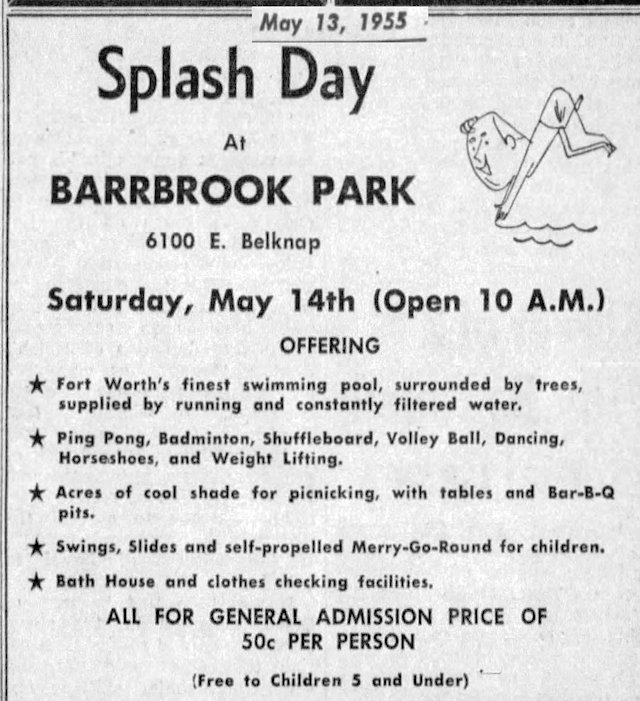
The park was popular for family picnics, swim meets, swimming and scuba lessons, the Miss Barrbrook beauty contest.
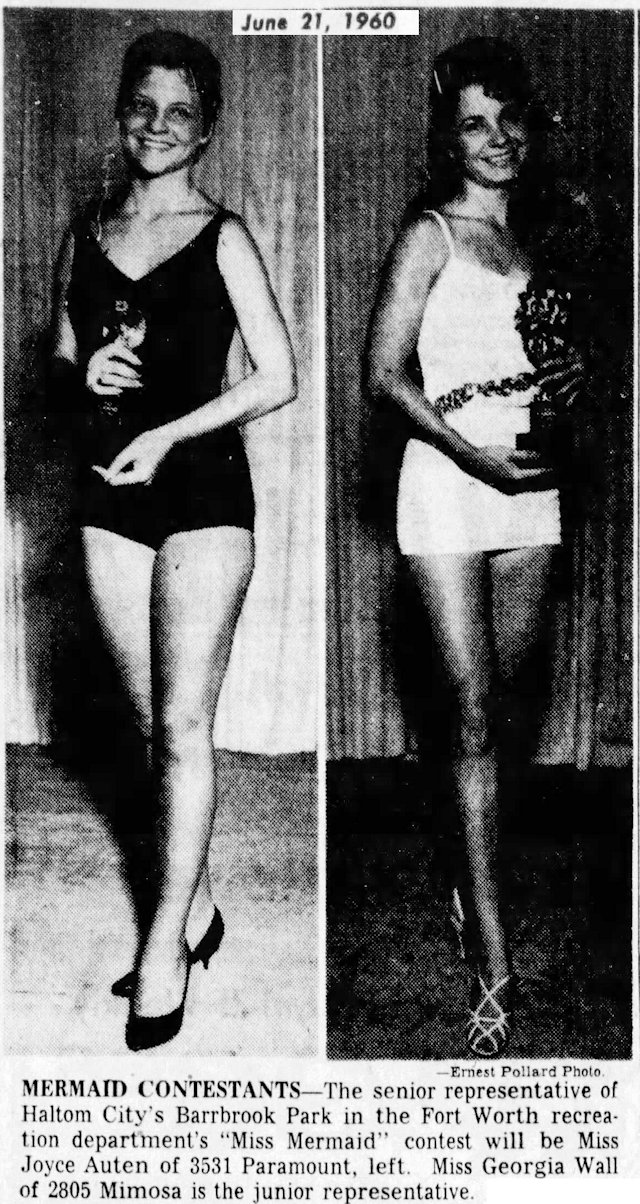
In 1960 Barrbrook sent two representatives to the Fort Worth recreation department’s Miss Mermaid contest.
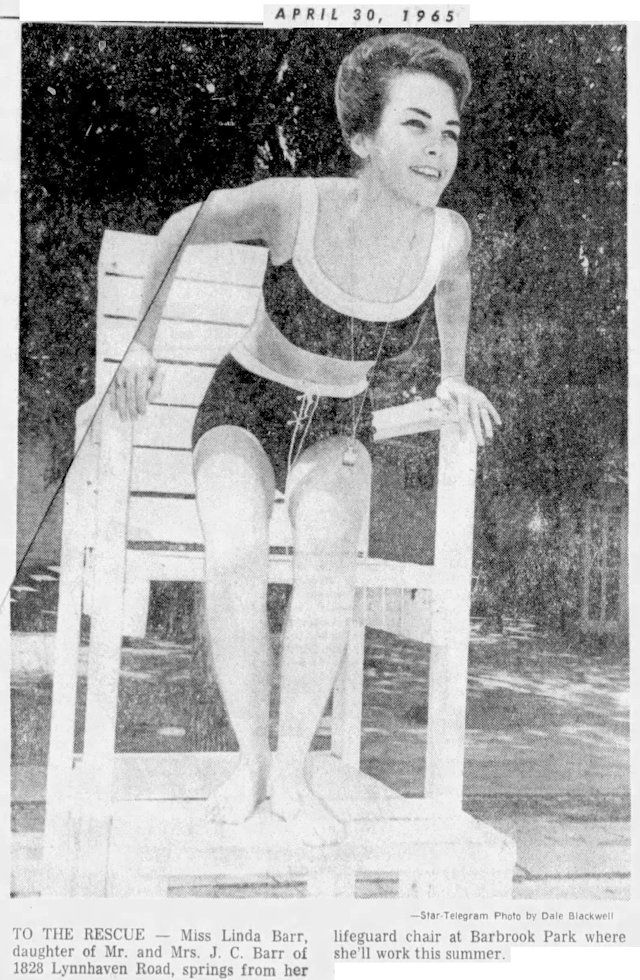
In 1965 one of the lifeguards was Linda Barr, daughter of J. C. Barr.
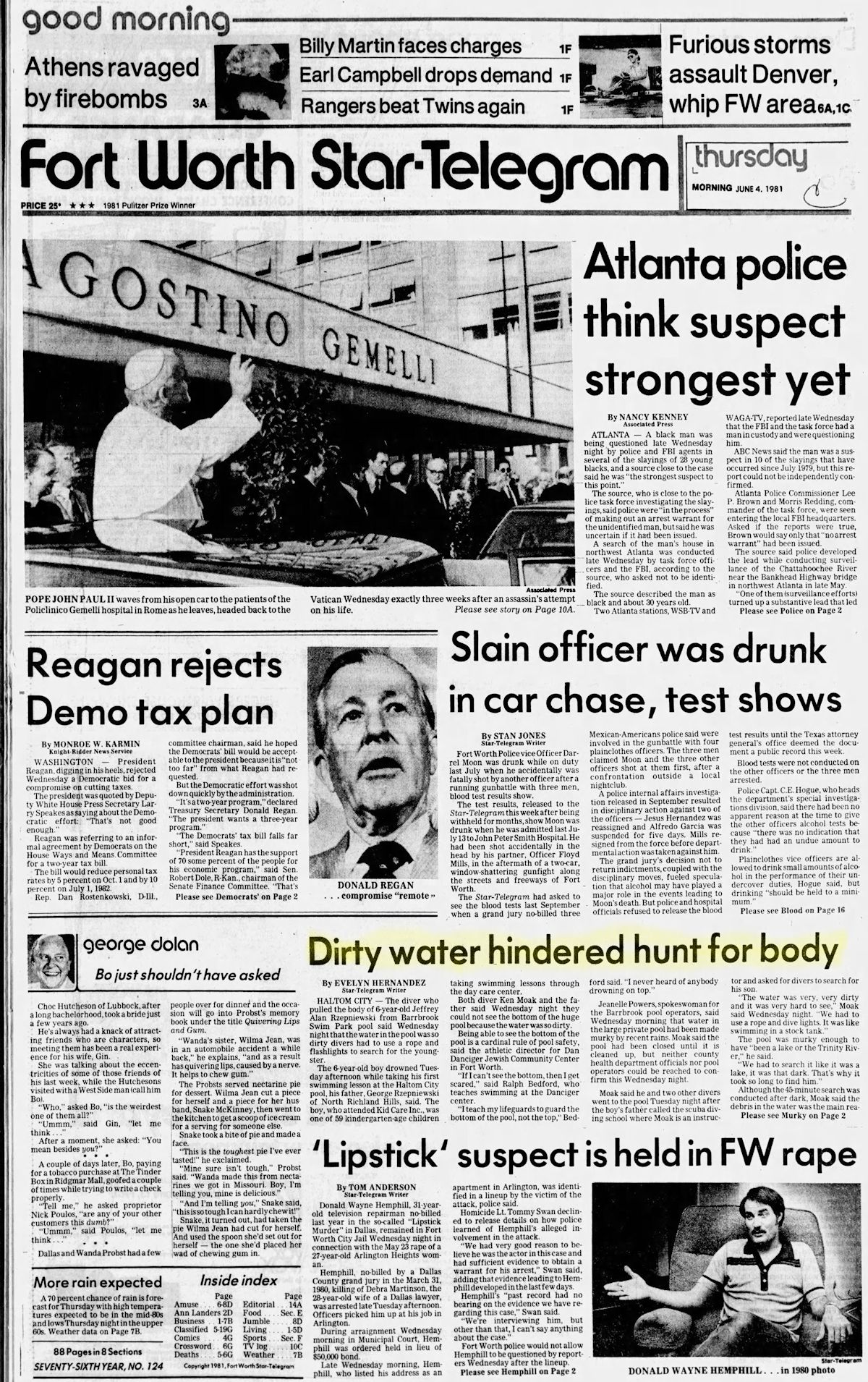
By 1981 the park had gone through two changes of ownership.
In June a six-year-old boy—a member of an outing of day-care children—drowned at Barrbrook. The water in the pool was so murky that no one saw his body after it slipped into the water. When people finally realized that the boy was missing, three divers using lights did not find the body for forty-five minutes.
Diver Ken Moak said, “The water was very, very dirty, and it was very hard to see. We had to use a rope and dive lights. It was like swimming in a stock tank.”
The boy’s parents sued the day-care center and the Barrbrook owners.
Here are two links to WBAP-TV news coverage of the drowning (video from UNT Libraries Special Collections):
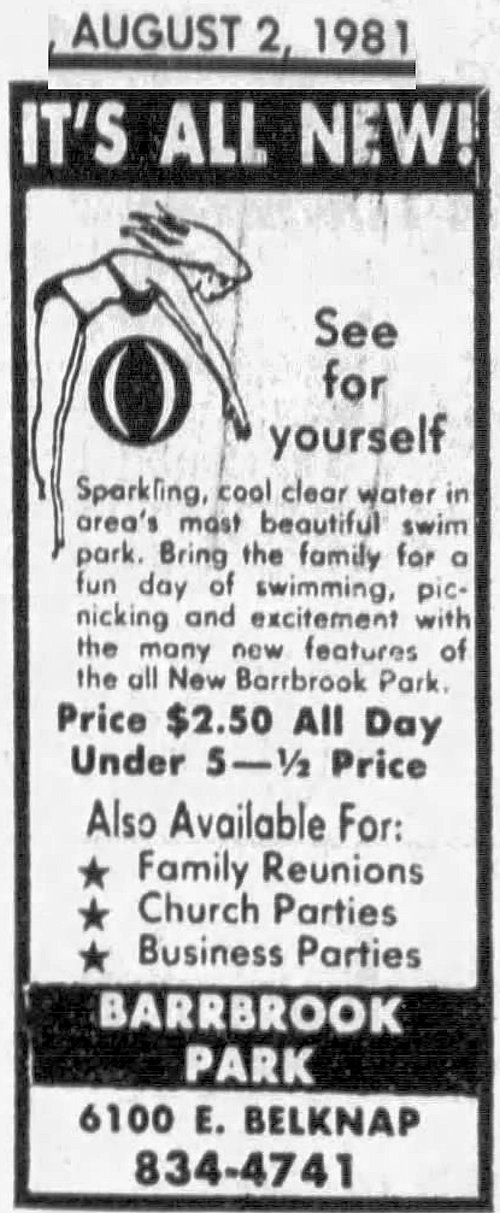
In August 1981 Barrbook attempted to regain public confidence with this ad: “all new,” “sparkling, cool clear water.”
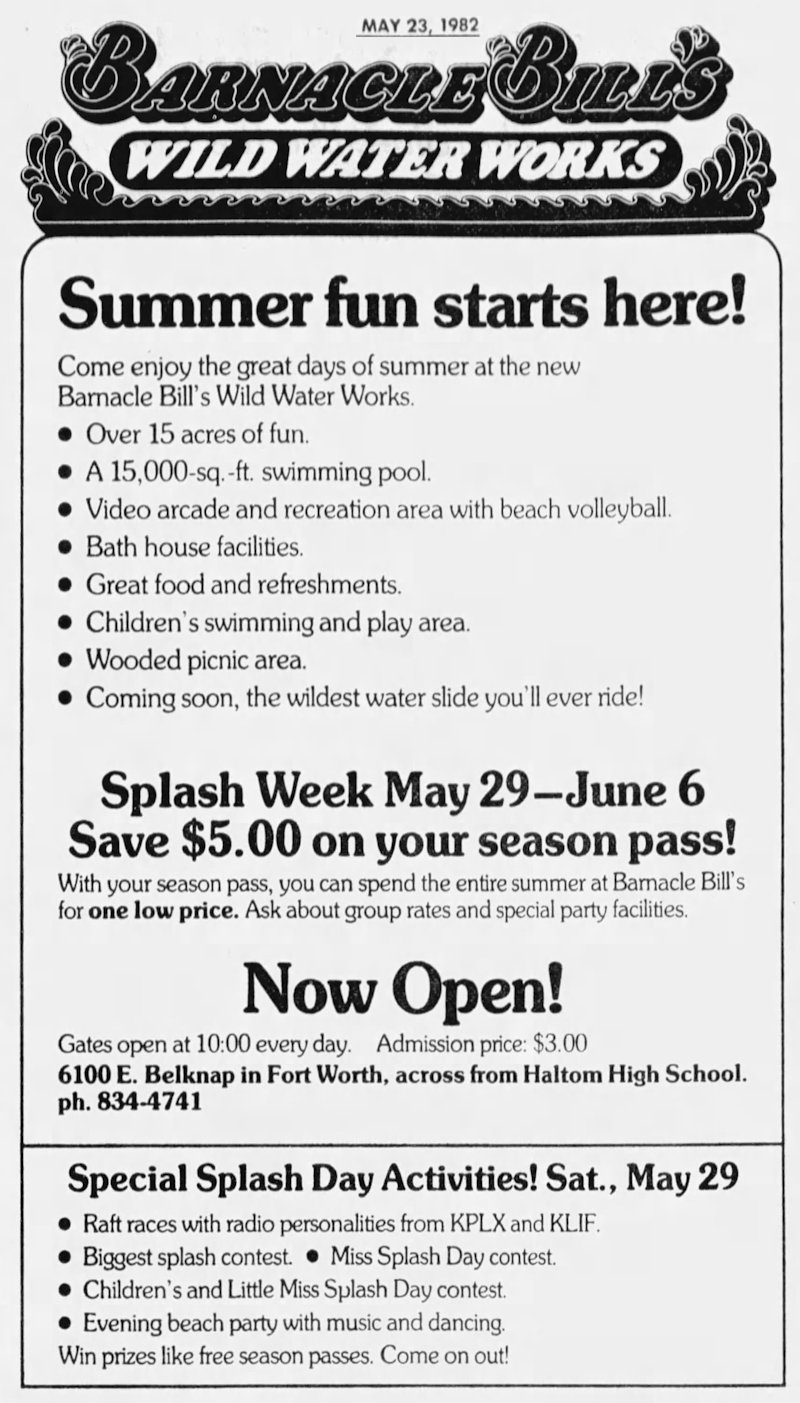
But by 1982 Barrbook had become “Barnacle Bill’s Wild Water Works.” The new incarnation did not operate long.

In 2002 ownership of the property reverted to the city of Haltom City. The park, long closed, had become overgrown, its pools used as illegal landfills and tagged with graffiti. In 2004 the city filled the pools with dirt.
This recent aerial photo shows where the two pools were.

When Lucas Triple L Park opened in 1955 it was even more secluded than Barrbrook. Lucas was located near the intersection of Bowen Road and California Lane, which in 1955 was mostly farmland southwest of the Arlington city limits.
The twenty-acre park had a 125-foot swimming pool and spaces for mobile homes and RVs.
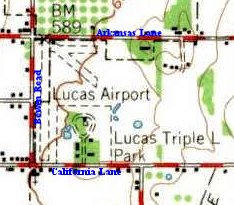
The Lucas family—Everett and Joy and son Donnie—also operated an airfield and flying school next to the park.
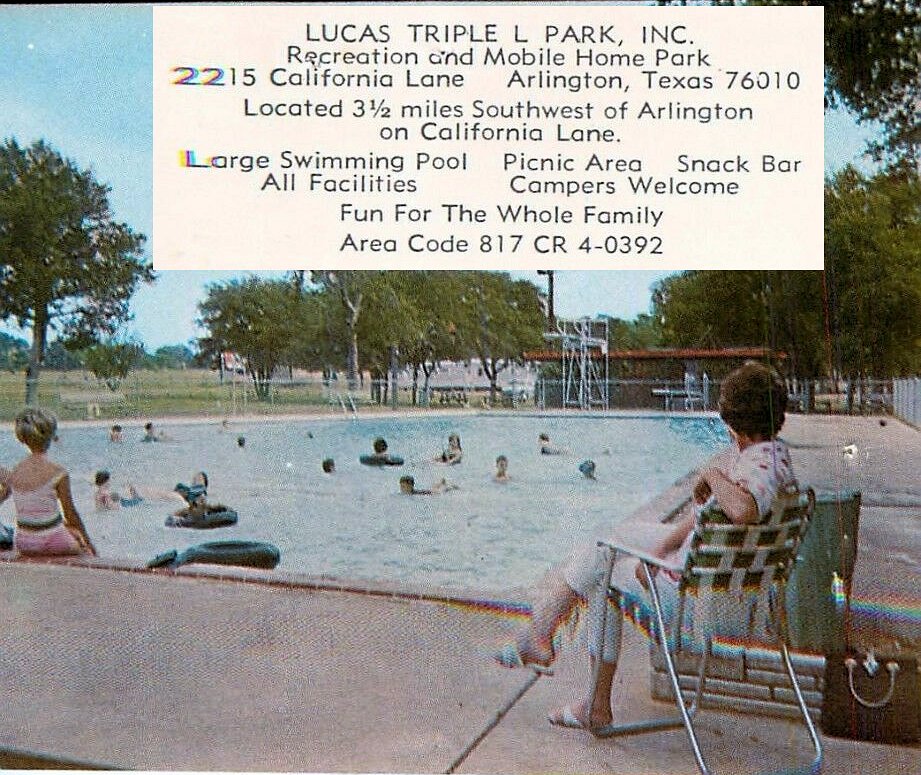
A postcard from the 1960s.

Lucas Park, like Barrbrook, was a popular venue for school group activities. For example, in 1964 the senior class of Arlington High School held its Senior Day picnic at Lucas.

The park closed in 1977 when Everett Lucas retired. He then developed most of the park property as Lucas Park housing addition. In the lower right of the plat, the Lucases retained a large lot where their home was.
If you look closely at the aerial photo you can see at least nine examples of what helped bring about the decline of municipal and commercial swimming pools: backyard pools.

(Thanks to Danny Hubbard for the suggestion.)





